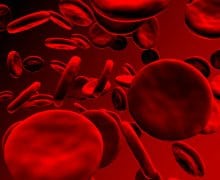Sickle cell is not a black disease, though it happens disproportionately in that population
What Is Sickle Cell Anemia?
A blood disorder caused by an inherited abnormal hemoglobin, sickle cell anemia is marked by distorted (sickled) red blood cells. The sickled red blood cells are fragile and prone to rupture. When the number of red blood cells decreases from rupture (hemolysis), anemia is the result. This condition is referred to as sickle cell anemia. The irregular sickled cells can also block blood vessels causing pain and tissue and organ damage.
Sickle cell anemia is one of the most common inherited blood anemias. The disease primarily affects Africans and African Americans. It is estimated that in the United States, 50,000 African Americans are afflicted with the most severe form of sickle cell anemia.
How is Sickle Cell Anemia Inherited?
Sickle cell anemia is inherited as an autosomal (meaning that the gene is not linked to a sex chromosome) recessive condition. This means the gene can be passed on from a parent carrying it to male and female children. In order for sickle cell anemia to occur, a sickle cell gene must be inherited from both the mother and the father.
The inheritance of just one sickle gene is called sickle cell trait or the “carrier” state. Sickle cell trait does not cause sickle cell anemia. People with sickle cell trait usually do not have many symptoms of disease and have normal hospitalization rates and life expectancies. Sickle cell trait is present in about 2 million people in this country. When two carriers of sickle cell trait mate, their offspring have a one in four chance of having sickle cell anemia.
Symptoms
Nearly all of the major symptoms of sickle cell anemia are the result of the abnormally shaped, sickled red blood cells blocking the flow of blood that circulates through the tissues of the body. The tissues with impaired circulation suffer damage from lack of oxygen. Damage to tissues and organs of the body can cause severe disability, with sufferers enduring episodes of intermittent “crises” of variable frequency and severity.
The major features of sickle cell anemia include:
Fatigue and anemia
Pain crises
Swelling in hands and feet and Arthritis
Bacterial infections
Pooling of blood in the spleen and liver congestion
Lung and heart damage
Leg ulcers
Eye damage
Some features of sickle cell anemia, such as fatigue, anemia and pain crises, can occur at any age. Many features typically occur in certain age groups. Sickle cell anemia usually first presents symptoms in the first year of life. Infants and younger children can suffer with fever, abdominal pain, pneumococcal bacterial infections, painful swellings of the hands and feet and blood pools in the spleen. Adolescents and young adults more commonly develop leg ulcers and eye damage. Symptoms in adult typically are intermittent pain episodes due to injury of bone, muscle, or internal organs.
Affected infants do not develop symptoms in the first few months of life because the hemoglobin produced by the developing fetus (fetal hemoglobin) protects the red blood cells from sickling. This fetal hemoglobin is absent in the red blood cells that are produced after birth so that by 5 months of age, the sickling of the red blood cells is prominent and symptoms begin.
Treatment
Sickle cell treatment is directed at the management and prevention of the acute manifestations as well as therapies directed toward blocking the red blood cells from clumping. There is no single remedy to reverse the anemia. It is, therefore, important that family members have an optimal understanding of the illness and that communication with the doctors and medical personnel be maintained.
What Is the Prognosis for Sickle Cell Patients?
The life expectancy of people with sickle cell anemia is reduced. Some patients remain symptom free for years, while others do not survive infancy or early childhood. With optimal management patients can now survive beyond age 40.
Research is examining ways to promote the development of the fetal hemoglobin to delay the development of sickle cell in newborns. Bone marrow transplants are being used for people with severe sickle cell anemia who have an identical twin. And genetic counseling can be helpful to prevent sickle cell anemia.
For more information on the history of and current treatments for sickle cell disease, watch the video below from Black Health Matter’s 2019 Summit.





